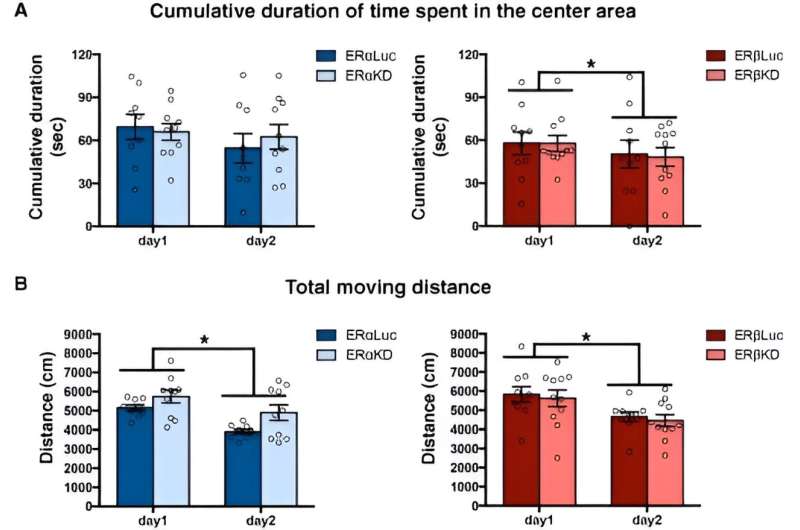Effects of ERα (left) and ERβ (right) knockdown in the LS on two behavioral measurements during the OFT. (A) Cumulative duration of time spent in the center area, and (B) total moving distance. Mice were tested in two consecutive days for 10 minutes each. Credit: Neuroscience (2023). DOI: 10.1016/j.neuroscience.2023.11.019
Estradiol (E2), a sex steroid hormone, plays an essential role in social behavior, including regulating social anxiety, which is anxiety experienced when unknown individuals are encountered. In males, testosterone secreted by the testes is converted to E2 in the brain, and the E2 binds to two types of estrogen receptors (ERs), ERα and ERβ, to regulate social behavior. However, its neuroendocrine basis has not been understood.
In a new study, published in Neuroscience, the role of ERα and ERβ expressed in the lateral septum (LS), which regulates social anxiety, was investigated using male mice.
The researchers first investigated the expression of ERα and ERβ in LS using genetically modified male mice. ERβ-expressing cells in the mice were labeled with red fluorescent protein, which revealed that the distributions of ERα and ERβ are different. Furthermore, the researchers investigated the knockdown effects of ERα or ERβ gene expression in the LS of male mice during situations of social and nonsocial anxiety.
The results show that social anxiety increases with the inhibition of ERβ expression. Additionally, ERα- and ERβ-positive cells in the LS projected into different regions of the hypothalamus.
Thus, the researchers concluded that ERα- and ERβ-expressing cells in LS are distinct cell populations with different localizations and neuronal projections, and the ERβ population plays a crucial role in neural circuitry that regulates anxiety-like behavior in social situations.
More information: Kansuke Hasunuma et al, Estrogen Receptor β in the Lateral Septum Mediates Estrogen Regulation of Social Anxiety-like Behavior in Male Mice, Neuroscience (2023). DOI: 10.1016/j.neuroscience.2023.11.019
Journal information: Neuroscience
Provided by University of Tsukuba























